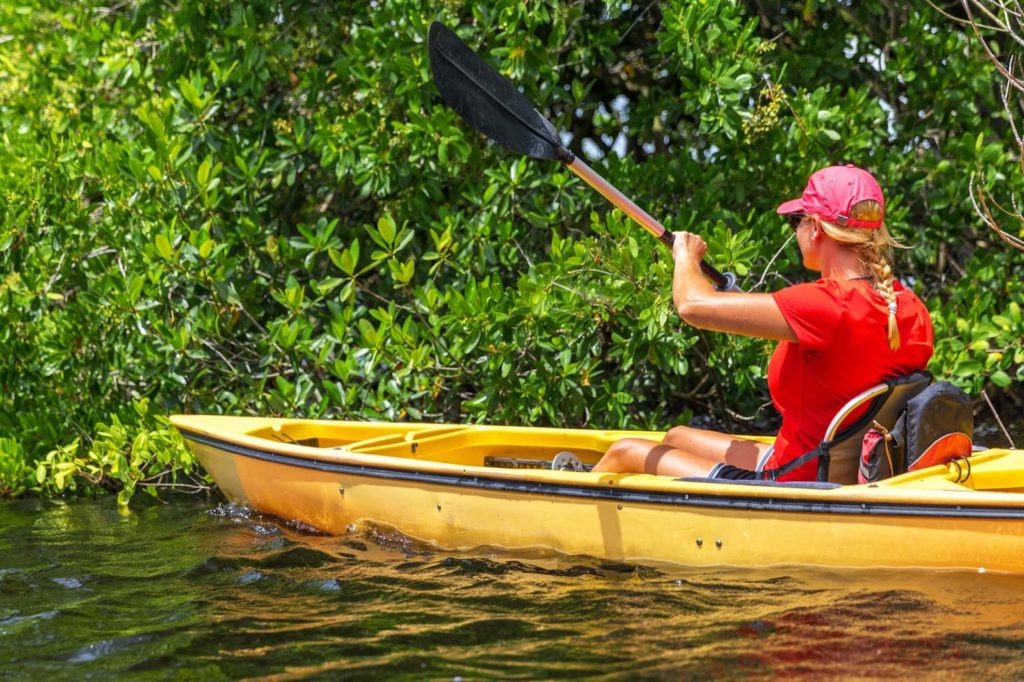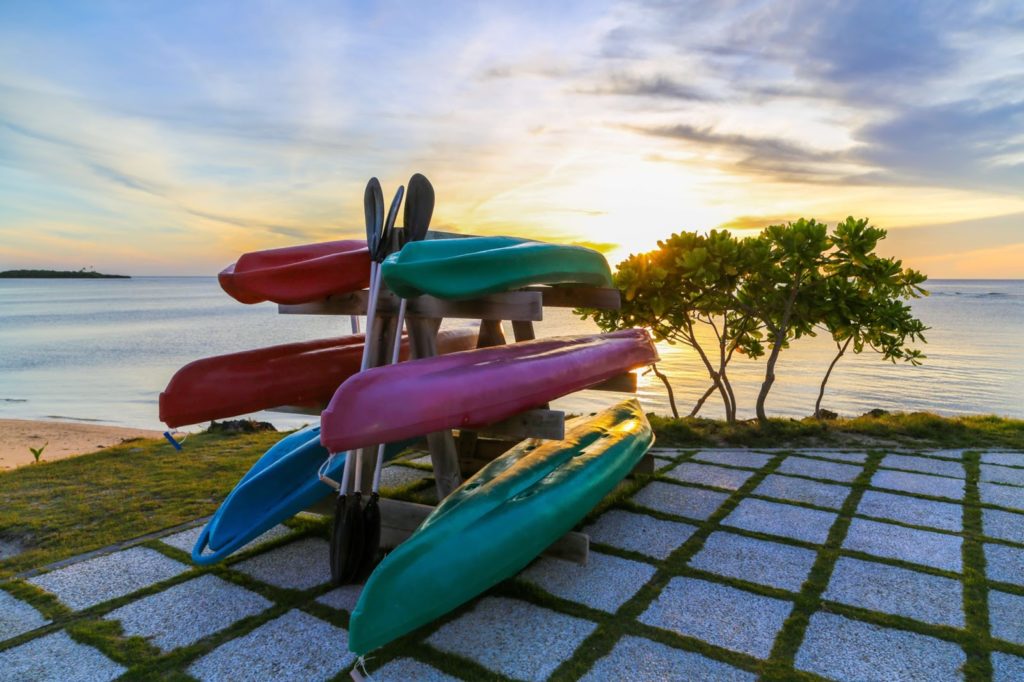A few hours of practice can help beginners learn the basics of paddling a kayak. While it may seem intimidating, kayaking is a simple, fun, and easy to learn water sport. It’s great for fitness, developing muscles, and coordination. Continue reading to learn how to paddle a kayak.
Kayaking in Three Easy Steps

This section will take you through how to launch your kayak, use your paddle, and perform basic kayak paddling techniques. For your first time kayaking, consider getting the help of an experienced kayaker for guidance.
1. Launching and Paddling Your Kayak
First, you need to understand the components of your boat. Different brands can have various features; however, some components are prevalent in most kayaks. For example, the cockpit is where you sit, and the place where you rest your feet is the deck. The very front of the kayak is the bow, whereas the back is called the stern.
To launch your kayak, choose a suitable location to lay down your boat, e.g., a beach or boat launch. Choosing the right place helps you stabilize yourself more quickly and set off with minimal complications.

This section will cover instructions for launching both a single and double kayak.
Step by Step Instructions for Launching Your Single Kayak
Step 1: Lay your kayak in the water and hold your paddle firmly in the middle.
Step 2: Approach the cockpit from the side and slowly lift one foot on the deck. Your kayak should be in the water, meaning that it will rock while you attempt to enter. Depending on where you decide to launch your kayak, your feet may get wet.
Step 3: Once one foot is firmly on the deck, shift your hips towards the cockpit and lower your body onto the seat. Lift the foot outside the kayak and place it within the cockpit. Now, you should be sitting comfortably in the seat.
Step 4: Place your hand outside the kayak to grab a solid surface. Use your hand to push against the surface so that your kayak moves towards deeper water.
Step 5: Use your paddle to push yourself away from the shore. Place one paddle blade in the water and move the blade to sweep the water backward.
Step 6: Turn your paddle so that the blade opposite the one in the water hangs in the air. Use your paddle to push the water backward. You should be moving forwards and away from the shore by this step.
Step by Step Instructions for Launching Your Double Kayak

Launching a double kayak (also called a tandem kayak) is similar to launching a single kayak.
Step 1: Choose who will ride in the cockpit closest to the bow, and follow steps 1-3 above to get inside the cockpit. The rear rider should hold both sides while the bowrider attempts to enter the kayak to stabilize the boat.
Step 2: Once the bowrider is inside, the rear rider should launch the kayak slightly and follow steps 1-3 above to go inside the cockpit. The rear rider is likely to get their feet wet when launching.
Step 3: Both riders should follow steps 5-6 above to paddle.
2. Using your paddle
To use your paddle, hold the shaft so that your hands are of equal distance apart from the blade. You should have a slightly wider than a shoulder-width length between your hands, and your knuckles should face upwards and in line with the edge of each blade.
Check that you are handling your paddle correctly by lifting it so that the middle of the shaft sits on your head. Both of your elbows should be at a 90-degree angle in opposite directions.

Maintain a secure grip on the shaft and stroke the blade through the water. Your control hand (the hand that controls the blade in water) should firmly grip the shaft, while your other hand should have a looser grip. A more flexible grip is necessary so that you can rotate the paddle. This rotation must occur with every single stroke in the water.
3. Performing basic strokes
Knowing several kayak paddling techniques and strokes helps you navigate and move in different directions. We will discuss the three basic strokes that allow you to move across the water.
Forward Stroke
To perform a forward stroke, place the blade in the water and as you sweep the blade towards the back, move your upper body forwards. Moving forwards helps you to perform the forward stroke more efficiently.

Steps for Performing a Forward Stroke
Step 1: Rotate your torso towards the other side of the blade you want to stroke through the water.
Step 2: Place the blade in the water and sweep it through it while unwinding your torso. The rotation helps to push your kayak forwards.
Step 3: Remove the blade from the water once it reaches the back, and your torso should be leaning towards the other side. Repeat step 2 for the other paddle and continue moving forwards.
Turning Stroke
A turning stroke helps you to turn your kayak in a different direction.
Steps for Performing a Turning Stroke
Step 1: Follow the steps above to complete a forward stroke to get momentum going.
Step 2: While performing a forward stroke, reach forward to place your blade closer to the kayak’s bow.
Step 3: Use your blade to sweep through the water in a broad stroke until your paddle reaches the kayak’s stern.
Step 4: Repeat step 3 with the same blade until you turn in the right direction and stop.
Draw Stroke
If you want to pull your kayak sideways without turning, a simple draw stroke can help. This stroke will help you move from side to side to line up with other kayakers so you can ride in parallel.

Steps for Performing a Draw Stroke
Step 1: Hold your paddle’s shaft firmly and place one blade directly parallel to the side of your torso. One side of the flat section of the blade should be facing your torso and the other outwards towards the direction you want to shift.
Step 2: Place the blade in the water and sweep the water towards the side of your boat.
Step 3: Continue sweeping inwards until you reach the correct position.
Understanding Your Equipment
There are multiple kayaking essentials that you need to participate in the sport. Firstly, you will need a kayak and paddle. The type depends on your preference, budget, and experience level. For example, beginners can benefit from having a ‘sit on top’ kayak without the cockpit to feel more stable and less confined.

All components of Kayak paddles can have different materials: plastic, fiberglass, and aluminum. The materials impact how lightweight the paddle is and how you can comfortably hold it.
Blades can be broader or narrower. Narrow blades have proven to be more suitable for longer kayaking adventures, whereas wider blades enable you to pave through the water more quickly. Paddle shafts can be bent or straight. Bent shafts are often more comfortable for your joints and muscles when paddling against water.
Kayakers also need a buoyancy aid such as a life jacket, sunscreen, first aid kit, and bug repellent. Store the first aid kit, repellent, and sunscreen in a waterproof container within your kayak. If you plan to spend a long time kayaking, you should use a wetsuit to help keep you warm throughout the day.
Conclusion
Kayaking is a simple, relaxing, and fun sport that can help to improve your strength, balance, and fitness. While some may find learning the kayaking strokes challenging, getting started is relatively simple. Grab your equipment and head out to the water for a fun kayaking experience. Use the guide above to help you learn how to paddle for the first time.
FAQs
How Does a Kayak Paddle Look?
A kayak paddle has three main components: the shaft and two blades attached to each side. The shaft appears like a long stick, and the blades are flat ‘boards’ that help direct the water when you paddle.
How Do You Use a Kayak Paddle?
To hold a kayak paddle, grip the shaft with both hands. Make sure that your hands are slightly further apart than the width of your shoulders. You should line your knuckles with the edge of the blades.
Keep both hands in the position described above and turn the paddle to keep one blade on the water. Sweep through the water and place the other blade in the water. How you move depends on which stroke you want to perform; however, make sure that you firmly grip the shaft.
What Conditions Are Best for Kayaking for Beginners?
Calm weather is best for beginners because it provides the ideal condition of the water. Low winds mean warmer weather and fewer waves, making it easy for beginners to move their paddle through the water. Moreover, few waves also mean that it is easier to change direction and keep track of the weaker paddlers in your group.
Are There Different Types of Kayak Paddles?
Yes, there are four main differences between kayak paddles: materials, length, blade shape, and shaft design. Brands also have different designs for each paddle. Certain paddles work best for different conditions, e.g., wider kayaks require longer paddles; taller kayakers require longer paddles.
